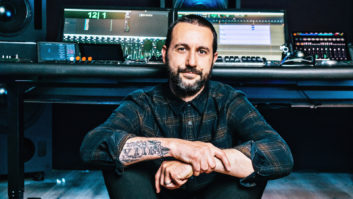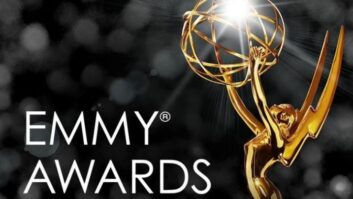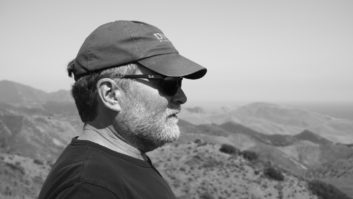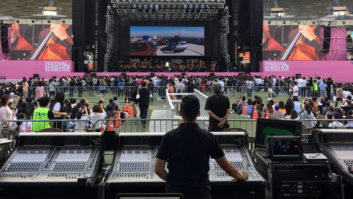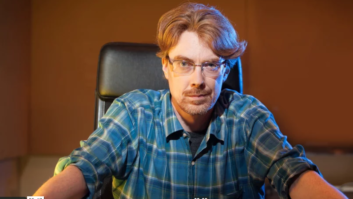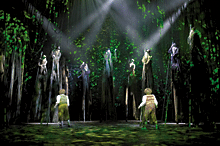
The depth, majesty and complexity of The Lord of the Rings trilogy were so masterfully rendered in J.R.R. Tolkien’s novels, critics wondered if Middle Earth could be brought to its full glory on the silver screen, but director Peter Jackson proved it could be done. But can the success of the novels and films be brought to the Broadway stage? Can the evil, powerful Sauron be effectively conveyed to an audience only feet away from the actors? To see if the ideals of Gandalf and the rest of the fellowship could survive the stage, we couldn’t turn down the opportunity to catch the opening of The Lord of the Rings musical at the Princess of Wales Theater in Toronto. The score for this ambitious production is performed under the capable direction of Chris Nightingale (who is also the orchestrator and musical supervisor), and performed by an ensemble of 15 live musicians and three keyboardists triggering the Vienna Symphonic Library Pro Edition sample sets off of G5 computers running Logic.
ONE SAMPLE TO RULE THE SHOW
We’re all familiar with orchestral samples that pop out of a stereo mix. Although they are often tucked under the sound of live players to add some beef, rarely — if ever — are samples used to the exclusion of musicians in high-profile films. So, we wondered, how effectively does the VSL — prominently exposed — move air in a large theatrical environment? Used to augment the few live string players in the ensemble and create large sections on their own, do they present any unusual mixing problems? And, by the way, how’s the music?
The score to TLOTR is unusual in that it features the work of three different creative talents. A.R. Rahman is a highly recognized composer from India. The son of a well-known music director in that country’s film industry, Rahman has been composing soundtracks for more than a decade, including work on Bombay Dreams, a musical that recently completed its Broadway run. Nightingale contributed a number of underscore cues to the show. Sound designer Simon Baker was also involved in setting up the mix templates for the production.
In development for almost three years, TLOTR presented a series of challenges for Nightingale, including blending music from two distinctly different compositional voices into the score. Finnish group Värttinä provides the otherworldly chorale material, and Rahman contributed a series of bluegrass-inspired tunes (Oklahoma meets a sitar-strumming Doc Watson), mostly delivered by the hobbits of Middle Earth.

Orchestrator/music supervisor Chris Nightingale
“I was flying all over the place, recording Värttinä, for example, and then bringing their songs into Logic,” says Nightingale. “I always knew that we were going to use the VSL Pro Edition, so I orchestrated to its strenghts. It wasn’t simply a case of throwing parts at a keyboard player or three and asking them to do the best they can.
“I’m extremely interested in the new Vienna Instruments engine, but it’s just come out and there’s no way we could have integrated it into this production,” Nightingale continues. “However, I’m very familiar with the articulations that the Pro Edition contains, and we made sure that the players we hired were able to use the Legato Tool, in particular, for the strings and other instruments.
“Our orchestra comprises a string quartet, double bass, three trombones, two French horns, one trumpet and two percussionists. The first violinist doubles on several ethnic string instruments, and we also have a flautist who doubles on piccolo and ethnic flute. Obviously, there was an economic motivation behind our decision to rely so heavily on samples, and we put a lot of time into considering how best to use them. VSL is used to strengthen the brass choirs and for string reinforcement. We also used its excellent harp quite a bit. I was concerned that in pianissimo passages, the samples might push too much air — occupy too much space. That’s a problem with samples: They can overwhelm. We spent a lot of time building dynamics into the keyboard parts to avoid this pitfall.”
The Princess of Wales Theater is a big room, and the multiple elements of the sonic pallette — singers, live players, samples and sound design — combine to form a dense and cohesive texture that yields an auditory experience closer to film than theater. The samples were never false-sounding, even when they were used to paint the picture of a large string section and mixed with the brash brass and commanding percussion parts, which were performed on acoustic instruments.
Those responsible for the sound included Phij Adams, the keyboard specialist who was charged with taking Nightingale’s finished score and making sure that the computer parts were as easy to play live as possible, and that computer redundancy was in place to ensure no catastrophic loss of music. He clearly put some thought into finding ways to maximize the realism of the samples. For example, late in the third act, while the full band wails away at triple forte, the strings hold a tremolo note in octaves. Real players never sit on a tremolo with equal speed or intensity, but the amount of hard drive space required to replicate these subtle shifts makes the effect impractical, so the static quality of the tremolo was obvious to an audio pro, but I doubt the average theatergoer would recognize this. As the ensemble decrescendoed into oblivion, the sampled strings disappeared, leaving the live players — who slowed their tremelos while fading away — to complete the task.
“Everything was considered,” says Adams. “Each of the three keyboardists outputs four stereo pairs to the console. We spent a lot of time setting levels at the computer to try and take some of the strain off of the mixers. VSL has a lot of dynamics built into its patches, which is great for studio work. But we couldn’t take the chance that a trombone, for example, would suddenly jump out of the pit, so I did a lot of velocity squeezing to make sure that didn’t happen. VSL did a good job setting up the mod wheel to switch between samples, but we wanted to get the most out of the players’ hands, so I wrote patches that use a foot player instead.”

All of the players are manning Yamaha S92 keyboards, with Logic 7 running on dual-processor G5s. “Of course,” Adams says, “anything can happen when you’re playing live, so we have mirrored systems for each of our players.”
DEEPER INTO THE SYSTEM
The show is using a Meyer Sound MICA P.A. system, augmented with a Meyer mid-center cluster and Meyer onstage monitors, which provide fallback for the cast. “We always knew we were going to include a lot of surround and sub-bass information,” Baker says. “Every bit of sound design I created had that concept in mind. We incorporate an awful lot of bass harmonic extenders, plus EQ and compression to deliver rumble in the sub-bass for those key moments.”
The pit at the Princess of Wales is almost completely enclosed, making it necessary to mike the ensemble. Depending on the number of instruments being played at one time, and the size of the cast that’s contributing to the sound at any moment, bleeding from the pit can present treacherous mix problems. “The density of the sound — and it is dense at times — is not really the problem,” Baker says. “But there are obstacles to overcome when you combine light folk material, heavy vocal arrangements and big orchestral cues in one score. Compared to a live rock show, for example, where the music sits on a narrow dynamic, it’s a huge challenge! Trying to create a seamless texture that sounds like one entity — particularly when you’re blending in keyboards — that’s the trick.”
However, the show’s audio crew was able to work out these bugs, partly because they are using two DiGiCo D5T mixers, which are modified for theater use. Andrew Bruce is the codesigner of the console; “He’s also the owner of Autograph, a rental and design company based in the UK,” Baker points out. “All of us who work at Autograph are familiar with the desk and have learned lots of little tricks to squeeze everything out of it that we can. For example, rather than numbered EQ presets, we have aliases that make it easy to switch between settings. Let’s say a character wears a hat in one scene and not in another. We enter different names for the character that make it simple to coordinate presets with scenes. These things really help when there’s a sudden change from folk music to orchestral underscoring. We’ve got separate reverbs for all of the keyboards, and they change throughout the course of the show. We tweaked the blend of reverb and predelay times on all of them to help ensure that they work well with the live instruments.
“For the first time, I’m using Logic for sound effects playback. Having the keyboards and the sound effects system using the same platform makes it easier to maintain the show. We’ve tried to get the electronic music and sound design to work as one department rather than two.”
Gary Eskow is a contributing writer to Mix.

